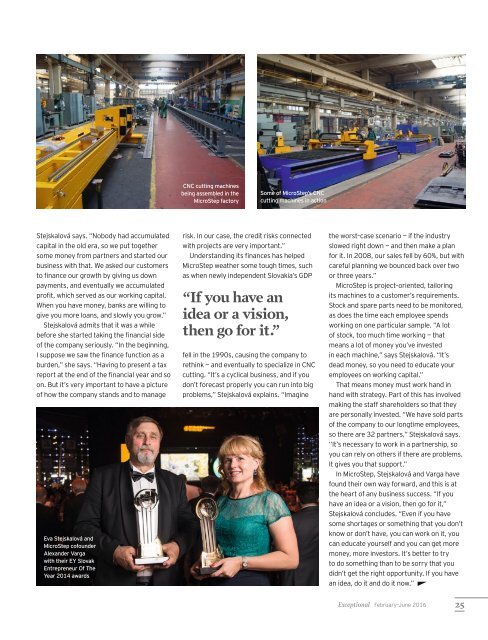Exceptional
ey-exceptional-2016-uki-book
ey-exceptional-2016-uki-book
Create successful ePaper yourself
Turn your PDF publications into a flip-book with our unique Google optimized e-Paper software.
CNC cutting machines<br />
being assembled in the<br />
MicroStep factory<br />
Some of MicroStep’s CNC<br />
cutting machines in action<br />
Stejskalová says. “Nobody had accumulated<br />
capital in the old era, so we put together<br />
some money from partners and started our<br />
business with that. We asked our customers<br />
to finance our growth by giving us down<br />
payments, and eventually we accumulated<br />
profit, which served as our working capital.<br />
When you have money, banks are willing to<br />
give you more loans, and slowly you grow.”<br />
Stejskalová admits that it was a while<br />
before she started taking the financial side<br />
of the company seriously. “In the beginning,<br />
I suppose we saw the finance function as a<br />
burden,” she says. “Having to present a tax<br />
report at the end of the financial year and so<br />
on. But it’s very important to have a picture<br />
of how the company stands and to manage<br />
Eva Stejskalová and<br />
MicroStep cofounder<br />
Alexander Varga<br />
with their EY Slovak<br />
Entrepreneur Of The<br />
Year 2014 awards<br />
risk. In our case, the credit risks connected<br />
with projects are very important.”<br />
Understanding its finances has helped<br />
MicroStep weather some tough times, such<br />
as when newly independent Slovakia’s GDP<br />
“If you have an<br />
idea or a vision,<br />
then go for it.”<br />
fell in the 1990s, causing the company to<br />
rethink — and eventually to specialize in CNC<br />
cutting. “It’s a cyclical business, and if you<br />
don’t forecast properly you can run into big<br />
problems,” Stejskalová explains. “Imagine<br />
the worst–case scenario — if the industry<br />
slowed right down — and then make a plan<br />
for it. In 2008, our sales fell by 60%, but with<br />
careful planning we bounced back over two<br />
or three years.”<br />
MicroStep is project–oriented, tailoring<br />
its machines to a customer’s requirements.<br />
Stock and spare parts need to be monitored,<br />
as does the time each employee spends<br />
working on one particular sample. “A lot<br />
of stock, too much time working — that<br />
means a lot of money you’ve invested<br />
in each machine,” says Stejskalová. “It’s<br />
dead money, so you need to educate your<br />
employees on working capital.”<br />
That means money must work hand in<br />
hand with strategy. Part of this has involved<br />
making the staff shareholders so that they<br />
are personally invested. “We have sold parts<br />
of the company to our longtime employees,<br />
so there are 32 partners,” Stejskalová says.<br />
“It’s necessary to work in a partnership, so<br />
you can rely on others if there are problems.<br />
It gives you that support.”<br />
In MicroStep, Stejskalová and Varga have<br />
found their own way forward, and this is at<br />
the heart of any business success. “If you<br />
have an idea or a vision, then go for it,”<br />
Stejskalová concludes. “Even if you have<br />
some shortages or something that you don’t<br />
know or don’t have, you can work on it, you<br />
can educate yourself and you can get more<br />
money, more investors. It’s better to try<br />
to do something than to be sorry that you<br />
didn’t get the right opportunity. If you have<br />
an idea, do it and do it now.”<br />
<strong>Exceptional</strong> February–June 2016<br />
25


